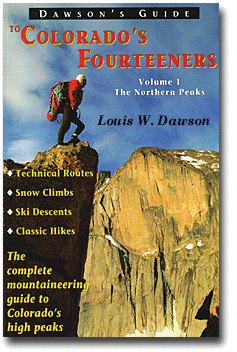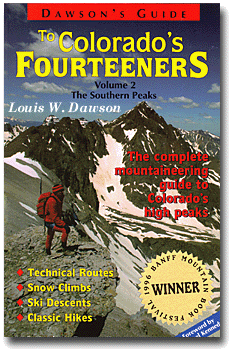Lou Dawson’s Colorado Fourteener Guidebooks
Dawson’s Guides to Colorado’s Fourteeners — Complete guidebooks to Colorado’s high peaks

Fourteeners volume 1.
These model guidebooks, written by well known Colorado mountaineer Louis (Lou) Dawson, are out of print (first published circa 1994). They may sometimes be obtained through the used book market. The author appreciates that these books have a life of their own, but wants readers to know the cultural information “Dawson’s Guide” conveys is dated and thus often inaccurate. They are best purchased as collector books, of for general research regarding the Colorado fourteeners.
Ground breaking and revolutionary, these were the first 14er guidebooks to detail ski and snowboard routes as well as winter climbing, yet still managed to include the standard summer routes. The two volumes, “Northern” and “Southern,” included what many still feel were the best maps to ever be included in a Colorado 14er peak guidebook, as well as one of the most interesting and well annotated collections of photographs — many of which are aerial views photographed by the author — involving much time and expense.

Fourteeners guidebook volume 2
Volume 1 of Dawson’s Guide to Colorado’s Fourteeners covers the 14,000 foot peaks in north and central Colorado. 255 pages. Ranges covered are the Sawatch, Mosquito, and Elk. The volume includes 31 full-page topographic maps. Also, dozens of photographs showing the routes, with notes and route-lines.
Volume 2 of Dawson’s Guide to Colorado’s Fourteeners covers the 25 14,000 foot peaks in southern Colorado. 206 pages. Ranges covered are the San Juan and Sangre De Cristo, and Pikes Peak. The volume includes 17 maps, copious photography, and a how-to section.
Foreword to Dawson’s Guide to Colorado Fourteeners, Vol. 1
by Jonathan WatermanWhen I first met Lou Dawson in May 1978, he was recovering from a spiral leg fracture that gimped him sure as an old man. Although such trauma would have jailed most mountaineers at home, he spent spring and summer guiding in his beloved Colorado Rockies. His natural affinity for suffering, moreover his bull-dog endurance, saw him stiff leggedly racing (and beating) his fittest students over high passes. I left to climb Mount Logan in Canada.
Several years later, in February after I’d climbed Denali, his mother phoned Alaska to tell me that an avalanche had broken both of Lou’s legs quite badly this time, again in the Colorado mountains. Doctors and friends figured that Lou would be hardpressed, physically and psychologically, to perform as a mountaineer. But that Thanksgiving, Lou proved them wrong. He hobbled to the top of Mount Elbert — Colorado’s highest alp — bivouacked, then skied to its base at dawn.
He seemed changed after that. He didn’t stop mountaineering, but he gave potential avalanche zones wider berths, carried a radio, and volunteered for Mountain Rescue. People who weren’t serious mountaineers thought he was still cheeky as ever, but his closest friends knew he had become somewhat of a “Fox of the fourteeners—” determined not only to avoid accidents, but to learn everything he could about the mountains he called home. At the same time, he initiated his most ambitious project: skiing all 54 of Colorado’s highest peaks.
It wasn’t until the fall of 1989 that I figured out what Lou was really doing. And it was no coincidence that I was trying to climb in Nepal. My trip was somewhat of a personal failure, because I had hoped to solo a big peak and I spent a lot of money traveling halfway around the globe only to realize that my partner in mountain rime had the answer all along.
Sure, Lou had been climbing in South America, Canada and Alaska. But he had found his Denali’s, his Mount Logans and his Himalaya in the backyard. While I sought mountaineering self-actualization in far ranges, Lou arrived upon Shangri-La in Colorado.
While slouching out of Nepal, I was determined to follow Lou’s lead. His brand of backyard mountaineering can be as raw as the arctic extremes of Alaska, and with the exception of extreme high altitude, the fourteeners offer similar technical challenges, scenic backpacking, gentle picnicking, or the ski descents to be expected from any great range in the world. It’s also cheaper.
As for the veracity of the guidebook itself, Lou did his field testing—fastidiously checking his odometer, obsessively tapping on his lap-tap computer and incessantly exposing film—as he finished skiing all the fourteeners in the spring of 1991. This was an unprecedented feat. Now, while I am attempt to grovel up the fourteeners in winter, face plant down them in the spring, or sweat up them in the summer, my success is owed to Lou’s inspiration, his companionship, and this book. Lacking the actual “Fox,” Colorado’s Fourteeners is Dawson in a box.
Foreword – Colorado 14ers Volume 2, Southern Peaks
by Michael Kennedy — Former Publisher and Editor-in-Chief — Climbing MagazineFor many of us, a particular mountain assumes a significance beyond what we’ve achieved on it, although it is often only in retrospect that we understand the nature of our relationship. So it has been for me with Capitol Peak*, a mountain close to home and close to heart.
My introduction to the perverse pleasures of winter climbing came in January 1974, when Lou Dawson and I made the second winter ascent of Capitol Peak’s North Face, during which I bagged my first new route, first gearless bivouac, and first near-death experience when, on the descent, I slid a hundred feet on the steep snow before being stopped by a rock. Over the next four years I climbed the North Face three more times, twice in summer and once again in winter, and after each of these climbs we’d come down Capitol’s Knife-edge Ridge. Although only a mildly technical scramble, it’s still one of the hardest standard routes on a Colorado Fourteener. I’d always wanted to make a one-day winter-conditions ascent of the “Knife,” and at the end of March 1991 decided that now was the time, even though I’d miss calendar winter by a week.
Spontaneity breeds simplicity. Skis for the approach, ice axe and crampons for the ridge, stove and food to keep the fire burning. Lightweight gear and years of experience had bred a certain efficiency and confidence. A chilly 4:30 a.m. saw me gliding along a well-frozen crust, hoarfrost sparkling in the headlamp’s beam. Slow and steady, I wandered up through pine and aspen as the sky brightened from purple to pink to blue. The dense forest gradually gave way to frozen lakes, windscoured snow, and rocky ridges against an electrically clear sky.
Five thousand feet from the valley floor, I stepped out of ski bindings and donned crampons. After a delicate scramble across the blade-like section of the ridge the route is named for, I plodded deliberately up the last half-mile of funky snow to the top. I gazed out over the familiar snowy landscape, thinking of other mountains beyond the horizon. Satisfied, I headed down. Almost too soon I was back at my car, bone-tired and thirsty, but full of the simple animal pleasure of 12 hours and 28 miles alone on a peak that had meant so much to me over so many years.
Lou Dawson and I have shared many adventures since 1974, from big-wall climbing in Yosemite and Alaska to long weekends in local huts with our wives and children, but for me that first climb on Capitol remains both a gift and an inspiration for all that has followed. Despite my fascination with the remote peaks of Alaska and the Himalaya, I’ve always come home to the mountains of Colorado.
Lou has never really left. No one understands the Colorado Rockies better or has a more intimate feel for their secrets, the kind of hard-won knowledge only gained from three decades of backcountry travel in all seasons. Thankfully, Lou continues to explore and learn, and thus inspire climbers in their travels in our magical backyard wilderness. May he do so for another 30 years.
[Note: Capitol Peak is a Colorado fourteener located in the Elk Mountains.]

